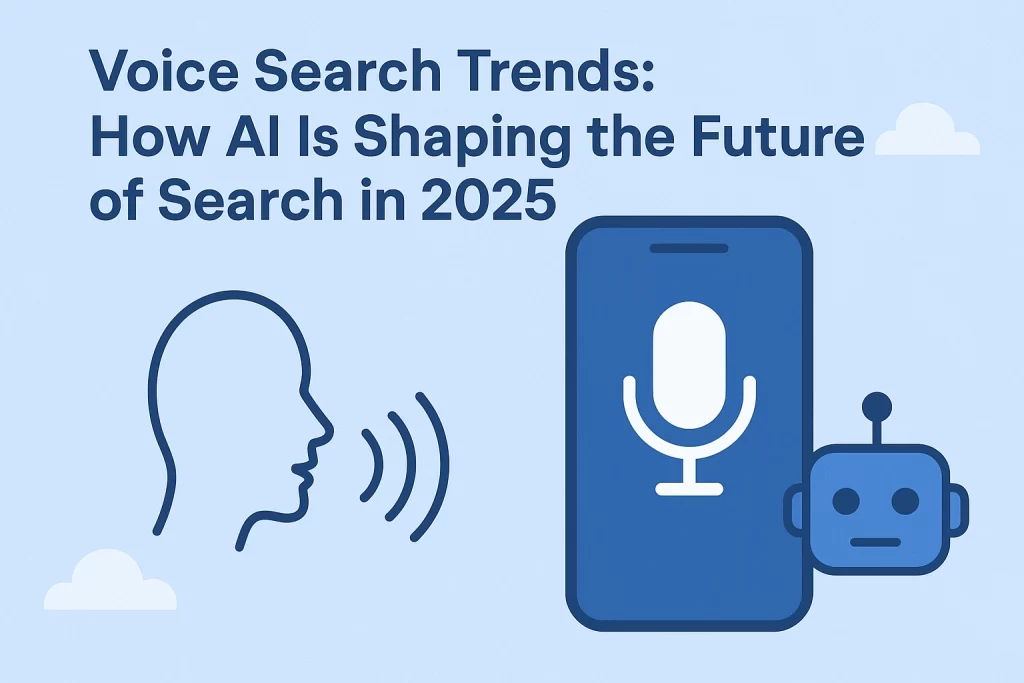The way people search online is changing — fast. From smartphones to smart speakers, users are increasingly talking instead of typing.
By 2025, more than half of all online searches are expected to be voice-based, signaling a fundamental shift in how SEO and content strategies work.
Welcome to the era of voice search trends, where keywords meet conversation, and intent drives interaction.
Voice search is no longer futuristic — it’s today’s reality. Businesses that adapt early will capture more organic traffic, improve user experience, and dominate AI-driven search results.
What Is Voice Search and Why It Matters
Voice search allows users to perform queries by speaking rather than typing.
Whether you say “Hey Siri,” “Okay Google,” or “Alexa,” your command is processed by AI and Natural Language Processing (NLP) algorithms to deliver an instant, conversational answer.
Unlike traditional search, voice queries are:
- Longer and more conversational
- Question-based (“What’s the best coffee near me?”)
- Context-aware (using location and history)
This means SEO now depends not only on keywords, but also on natural language, context, and user intent.
Voice Search Trends 2025: What’s Changing
As we step into 2025, the landscape of voice search is transforming rapidly. Below are the major voice search optimization trends 2025 that businesses and marketers need to understand.
1. Conversational Queries Are Taking Over
Voice searches tend to sound like natural speech rather than robotic keyword strings.
For example, a typed query might be “best SEO agency Dubai,” while a voice query could be “Which is the best SEO agency in Dubai near me?”
This conversational nature means content must mirror how people talk, not how they type.
Use long-tail, question-style phrases in your content and FAQs (e.g., “how,” “what,” “where,” “why”).
2. Featured Snippets Dominate Voice Results
More than 60% of voice answers come directly from featured snippets — the short boxes you see at the top of Google results.
This makes snippet optimization crucial for voice visibility.
Structure content using clear headings, bullet lists, and direct answers to frequently asked questions.
3. Local SEO and “Near Me” Searches Are Growing
Voice search is hyper-local.
Queries like “best pizza near me” or “SEO consultant open now” have skyrocketed.
This shows that users rely on voice for immediate, local results.
Optimize Google Business Profiles, ensure consistent NAP (Name, Address, Phone), and target local intent keywords like “voice search optimization services in Dubai.”
4. Mobile and Smart Devices Are the Primary Channels
Most voice searches happen on mobile devices, followed by smart speakers like Amazon Echo, Google Home, and Siri-enabled devices.
With the rise of IoT, voice interactions are now embedded into TVs, cars, and even home appliances.
By 2025, these touchless experiences will become standard.
Ensure mobile-first optimization — fast loading, responsive design, and schema markup are essential.
5. Multilingual Voice Search Is Expanding
In multilingual markets like the UAE and India, voice assistants are becoming increasingly proficient at handling local languages and accents.
Search engines now interpret regional dialects and code-mixed queries (like “best restaurant khula hai near me”).
Include multilingual keywords, optimize content for voice in different languages, and focus on region-specific SEO.
6. AI-Powered Personalization
Voice assistants like Alexa, Google Assistant, and Siri now personalize answers based on user history, preferences, and behavior.
In 2025, AI-driven personalization will be central to voice search optimization trends.
Marketers must deliver contextually relevant content that adapts to individual needs.
Implement structured data and create content clusters around user intent.
SEO Trends for Voice Search in 2025
To stay ahead, marketers must rethink SEO fundamentals. Traditional ranking factors still matter, but voice SEO adds a new dimension.
Here are the most important SEO trends for voice search this year:
1. Focus on Natural Language SEO
Google’s BERT and MUM updates understand human language contextually.
This means your SEO should sound human, not mechanical.
Use:
- Conversational tone
- Simple sentence structures
- Question-answer formats
This approach helps your content align with the logic of voice assistants.
2. Optimize for Zero-Click Results
Most voice searches don’t lead to a click — users get the answer directly.
That’s why zero-click SEO is now a key part of voice search trends.
Focus on:
- FAQ pages
- Schema markup
- Clear, concise answers (under 30 words for voice snippets)
3. Improve Page Speed and Core Web Vitals
Voice searches demand quick answers.
If your page takes too long to load, search engines will skip it.
Ensure:
- Page load time under 2.5 seconds
- Mobile-first design
- Image compression and lazy loading
4. Optimize for Question Keywords
Use tools like AnswerThePublic or Semrush to find question-based queries.
For instance:
- “How are agencies adapting to voice search trends?”
- “What are the top voice search optimization trends in 2025?”
Answering these queries helps your content appear in both voice and traditional search results.
5. Structured Data and Schema Are Essential
Schema markup tells search engines what your content is about.
Adding structured data helps your content appear in rich results, which voice assistants prefer.
Add schema for:
- FAQs
- Reviews
- How-to guides
- Local business info
How Are Agencies Adapting to Voice Search Trends?
Digital marketing agencies worldwide are rethinking their SEO strategies to adapt to the voice-first era.
Here’s how the best agencies are making the shift:
1. Integrating Voice SEO into Core Strategy
Agencies now treat voice optimization as a standard SEO component.
They analyze how voice queries differ from text and tailor keyword strategies accordingly.
2. Creating Conversational Content
Modern agencies develop content that sounds natural when read aloud.
This includes optimizing for long-tail keywords, FAQs, and structured responses that match spoken language patterns.
3. Using AI Tools for Query Prediction
With the rise of AI-driven SEO, agencies use predictive analytics to forecast voice-based queries.
Tools powered by machine learning analyze speech patterns, regional terms, and contextual behavior to identify future trends.
4. Enhancing Local SEO Integration
Agencies ensure clients’ local presence is voice-search friendly by:
- Updating business listings
- Managing local citations
- Optimizing “near me” content
- Implementing local schema
5. Adopting Multimodal Search Optimization
Voice search is increasingly combined with visual and text-based search.
Leading agencies now integrate voice + visual SEO, preparing brands for the next phase — multimodal search.
6. Measuring Voice Search Performance
Since traditional analytics don’t directly track voice search, agencies use AI-based analytics and SERP monitoring tools to estimate voice visibility.
They evaluate:
- Featured snippet appearances
- FAQ engagement rates
- Voice-driven conversions
How Wildnet Technologies Helps Businesses Stay Ahead
As a leading provider of Digital Marketing Services, Wildnet Technologies helps brands stay future-ready with comprehensive voice search optimization strategies.
From keyword mapping to conversational content and schema integration, Wildnet’s experts ensure your business is optimized for the way people search today — and tomorrow.
Their goal: make your brand the first answer voice assistants deliver.
The Future of Voice Search Optimization
The future of SEO is hands-free, conversational, and AI-driven.
Voice search will soon merge with predictive AI and multimodal experiences, creating a seamless, intuitive way for users to interact with brands.
Businesses that embrace voice search trends 2025 early will:
- Rank higher on conversational searches
- Improve accessibility and engagement.
- Build long-term brand loyalty.
Voice search is not just a technology trend; it’s a behavioral revolution redefining digital discovery.
Conclusion
Voice search is changing how users find, engage, and interact with online content.
From natural language to AI-driven personalization, voice search trends are shaping the SEO landscape for years to come.
To stay ahead, focus on:
- Conversational keyword optimization
- Local SEO and schema markup
- Fast, mobile-friendly experiences
- AI-powered personalization
Whether you’re an individual brand or an agency, adapting now means thriving in a future where your audience speaks—not types—its intent.
FAQs
1. What are the main voice search trends in 2025?
Conversational queries, AI personalization, local SEO, and featured snippet optimization are dominating voice search trends in 2025.
2. How are agencies adapting to voice search trends?
Agencies integrate AI tools, conversational content, and local SEO strategies to make client websites voice-search friendly.
3. What is voice search optimization?
It’s the process of optimizing website content and structure to rank for spoken search queries across devices like Alexa and Siri.
4. How does voice search affect SEO?
Voice search changes keyword patterns, focusing more on natural, long-tail, and question-based queries rather than short phrases.
5. How can businesses prepare for future voice search trends?
By optimizing for conversational language, improving page speed, and using structured data to enhance search visibility.






